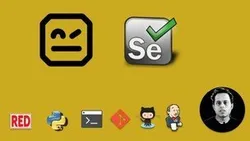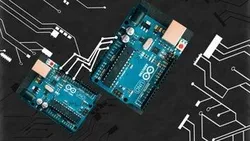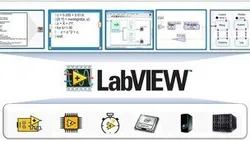
Learning Arduino: Foundations 
Learn the basics of Arduino and gain the skills to create your own projects. This course covers the fundamentals of Arduino boards and programming, providing the foundation to bring your ideas to life. ▼
ADVERTISEMENT
Course Feature
![]() Cost:
Cost:
Free Trial
![]() Provider:
Provider:
LinkedIn Learning
![]() Certificate:
Certificate:
No Information
![]() Language:
Language:
English
Course Overview
❗The content presented here is sourced directly from LinkedIn Learning platform. For comprehensive course details, including enrollment information, simply click on the 'Go to class' link on our website.
Updated in [March 06th, 2023]
1. You can learn the fundamental features and capabilities of an Arduino board, giving you the knowledge you need to begin programming your own projects.
2. You can learn how to configure the Arduino board with the Arduino IDE.
3. You can learn how to connect an LED to your Arduino board and write a programme to make the LED lights blink.
4. You can learn about pushbuttons, understanding why they are considered inputs to the Arduino board and how to activate an LED using a pushbutton.
5. You can gain the confidence to create your own Arduino projects and explore the possibilities of the Arduino board.
[Applications]
After completing this course, learners can apply their knowledge to create their own Arduino projects. They can use the Arduino IDE to write code and configure the board, and use the knowledge gained to connect LEDs, pushbuttons, and other components to the board. Learners can also use the knowledge gained to create more complex projects, such as controlling motors, reading sensors, and creating interactive displays.
[Career Paths]
1. Arduino Programmer: An Arduino programmer is responsible for writing code for Arduino boards. They must be familiar with the Arduino IDE and be able to write code that is optimized for the board. They must also be able to troubleshoot any issues that arise with the code. As the demand for Arduino-based projects increases, the need for experienced Arduino programmers will also increase.
2. Robotics Engineer: Robotics engineers are responsible for designing, building, and programming robots. They must be familiar with the Arduino board and be able to use it to create robots that can perform a variety of tasks. As the demand for robots increases, the need for experienced robotics engineers will also increase.
3. IoT Developer: IoT developers are responsible for creating applications that can interact with the physical world. They must be familiar with the Arduino board and be able to use it to create applications that can interact with sensors, actuators, and other devices. As the demand for IoT applications increases, the need for experienced IoT developers will also increase.
4. Embedded Systems Engineer: Embedded systems engineers are responsible for designing and developing embedded systems. They must be familiar with the Arduino board and be able to use it to create embedded systems that can perform a variety of tasks. As the demand for embedded systems increases, the need for experienced embedded systems engineers will also increase.
[Education Paths]
1. Electrical Engineering: Electrical engineering is a field of engineering that deals with the study and application of electricity, electronics, and electromagnetism. It is a rapidly growing field, with new technologies and applications being developed every day. Electrical engineers are responsible for designing, developing, and testing electrical systems and components, such as motors, generators, and power systems. With the increasing demand for energy efficiency and renewable energy sources, electrical engineers are in high demand.
2. Computer Science: Computer science is the study of computers and their applications. It involves the design, development, and implementation of computer systems and software. Computer scientists are responsible for developing algorithms, designing computer systems, and creating software applications. With the increasing demand for computer systems and software, computer science is a rapidly growing field.
3. Robotics: Robotics is the study of robots and their applications. It involves the design, development, and implementation of robotic systems and components. Robotics engineers are responsible for designing, developing, and testing robotic systems and components, such as sensors, actuators, and controllers. With the increasing demand for automation and artificial intelligence, robotics is a rapidly growing field.
4. Mechatronics: Mechatronics is a field of engineering that combines mechanical engineering, electrical engineering, and computer science. It involves the design, development, and implementation of mechatronic systems and components. Mechatronics engineers are responsible for designing, developing, and testing mechatronic systems and components, such as motors, sensors, and controllers. With the increasing demand for automation and intelligent systems, mechatronics is a rapidly growing field.
Course Syllabus
What is an Arduino?
The Arduino layout
Digital interfaces
Analog interfaces
The power pins
Course Provider

Provider LinkedIn Learning's Stats at AZClass
Discussion and Reviews
0.0 (Based on 0 reviews)
Explore Similar Online Courses

Robot Framework RIDE & Selenium - Step by Step for Beginners

Creative writing and critical reading

Python for Informatics: Exploring Information

Social Network Analysis

Introduction to Systematic Review and Meta-Analysis

The Analytics Edge

DCO042 - Python For Informatics

Causal Diagrams: Draw Your Assumptions Before Your Conclusions

Whole genome sequencing of bacterial genomes - tools and applications

Arduino Communication with SPI Protocol

Interfacing LabVIEW With Arduino via LINX

Arduino SMS Sending Motion Detector using Python
 Related Categories
Related Categories
 Popular Providers
Popular Providers
Quiz
 Submitted Sucessfully
Submitted Sucessfully
1. What is the Arduino IDE used for?
2. What is the purpose of a pushbutton?
3. What is the main purpose of this course?


Start your review of Learning Arduino: Foundations